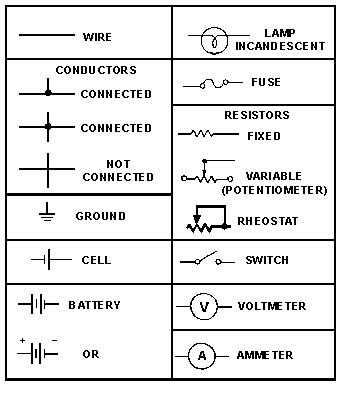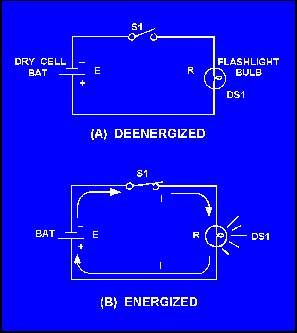|
THE BASIC ELECTRIC CIRCUIT
The flashlight is an example of a basic electric circuit. It contains a source of electrical energy (the dry cells in the flashlight), a load (the bulb) which changes the electrical energy into a more useful form of energy (light), and a switch to control the energy delivered to the load.
Before you study a schematic representation of the flashlight, it is necessary to define certain terms. The LOAD is any device through which an electrical current flows and which changes this electrical energy into a more useful form. Some common examples of loads are a
lightbulb, which changes electrical energy to light energy; an electric motor, which changes electrical energy into mechanical energy; and the speaker in a radio, which changes electrical energy into sound. The SOURCE is the device which furnishes the electrical energy used by the load. It may consist of a simple dry cell (as in a flashlight), a storage battery (as in an automobile), or a power supply (such as a battery charger). The SWITCH, which permits control of the electrical device, interrupts the current delivered to the load.
SCHEMATIC REPRESENTATION
The technician's main aid in troubleshooting a circuit in a piece of equipment is the SCHEMATIC DIAGRAM. The schematic diagram is a "picture" of the circuit that uses symbols to represent the various circuit components; physically large or complex circuits can be shown on a relatively small diagram. Before studying the basic schematic, look at figure 3-1.
This figure shows the symbols that are used in this chapter. These, and others like them, are referred to and used throughout the study of electricity and electronics.
Figure 3-1. - Symbols commonly used in electricity.

The schematic in figure 3-2 represents a flashlight. View A of the figure shows the flashlight in the off or deenergized state. The switch (S1) is open. There is no complete path for current (I) through the circuit, and the bulb (DS1) does not light. In figure 3-2 view B, switch S1 is closed. Current flows in the direction of the arrows from the negative terminal of the battery (BAT), through the switch (S1), through the lamp (DS1), and back to the positive terminal of the battery. With the switch closed the path for current is complete. Current will continue to flow until the switch (S1) is moved to the open position or the battery is completely discharged.
Figure 3-2. - Basic flashlight schematic.

In figure 3-2, what part of the circuit is the (a) load and (b) source?
What happens to the path for current when S1 is open as shown in figure 3-2(A)?
What is the name given to the "picture" of a circuit such as the one shown in figure 3-2?
|
|



